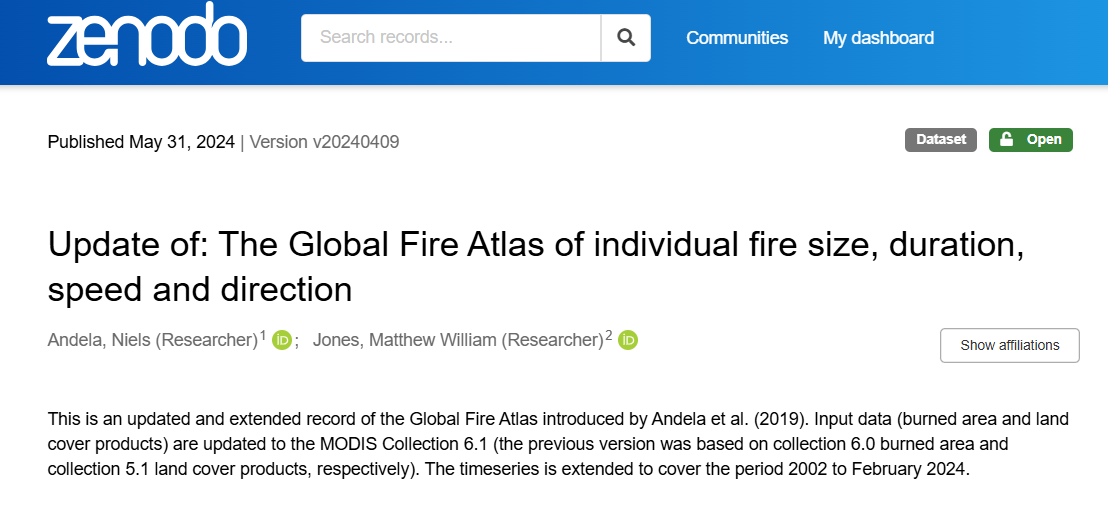INTRODUCTION
On April 3rd, the SPECIAL research group at the University of Reading hosted researchers from the University of East Anglia for a seminar exploring how fire science can move beyond burned area. The session focused on tools and datasets, like the “Global Fire Atlas”, that help researchers assess extreme fires and model various fire characteristics at a global scale. The event concluded with SPECIAL Group Postdoc Dr. Olivia Haas, who shared insights from the eco-evolutionary fire modelling project currently being developed by the Leverhulme/LEMONTREE joint fire-vegetation interactions team.
Our guests included Dr. Matt Jones and two of his PhD students, Alice Hsu and Esther Brambleby. Their presentations covered a wide range of fire research topics, from fire atlases and lightning-ignited wildfires to a new global dataset on prescribed burning.
BEYOND BURNED AREA
Dr. Matt Jones opened the seminar by challenging the field’s traditional focus on burned area as the dominant fire metric. While burned area remains important, being widely used for comparisons across studies, it doesn’t always tell the full story.
For instance, burned area doesn’t capture key fire characteristics such as intensity or rate of spread. This is critical because many of the most devastating fires in recent history, like Australia’s Black Summer bushfires and wildfires in California, were notable not just for their size, but for their speed and severity. These intense fires can have significant social and economic impacts, which aren’t always reflected in burned area statistics alone. By expanding the focus to include other fire properties, scientists can better understand and anticipate fire behaviour in a changing world.
THE NEED TO TRACK INDIVIDUAL FIRES
To study fire characteristics beyond area alone, researchers must identify and track individual fires across time and space. This requires several steps:
- Collect satellite data to detect burned area.
- Identify ignition points to estimate where and when a fire began.
- Determine fire progression to trace the spread of a single fire.
Several tools – such as the Global Fire Atlas, FRY, and GlobFire – can support this kind of analysis. Each tool uses different methods to define and separate individual fires, and it remains unclear how these differences may influence downstream fire modelling.
Despite methodological variations, the Global Fire Atlas offers a rich dataset, capturing not only burned area but also fire intensity, growth rate, and carbon emissions. This additional detail makes it a powerful resource for investigating other fire properties.
USING THE FIRE ATLAS TO UNDERSTAND LIGHTNING-IGNITED FIRES
PhD student Esther Brambleby demonstrated how the Global Fire Atlas can be combined with the Vaisala Global Lightning Dataset to identify lightning-ignited fires in the extra-tropics. While lightning is a common ignition source globally, data on lightning-initiated fires remains limited in spatial coverage.
By examining lightning strikes in the vicinity of fire ignition points, Esther developed a method to probabilistically determine which stroke likely started a given fire. Validating this approach against known lightning-ignited events improves our ability to expand the global dataset and refine our understanding of natural ignition sources.
BEYOND WILDFIRES – TRACKING PRESCRIBED BURNING
Alice Hsu presented her newly published global dataset on prescribed burning, compiled from public repositories, agencies, and NGOs. The dataset includes over 204,000 records from 16 countries, with detailed metadata on weather conditions, fuel types, biome classifications, and, crucially, the timing of each burn.
Understanding when prescribed burns are carried out is essential for assessing how burning windows might shift under climate change. Alice’s work provides a foundation for modelling the future viability and safety of prescribed fire practices under evolving climate conditions.
ECO-EVOLUTIONARY OPTIMALITY THEORY FOR FIRE
Dr. Olivia Haas concluded the day by presenting the SPECIAL group’s work on an eco-evolutionary optimality (EEO) model for fire. This framework seeks to explain global fire patterns using fundamental environmental drivers, specifically, gross primary productivity (GPP) and vapor pressure deficit (VPD).
GPP determines the amount of available fuel, while VPD influences how quickly that fuel dries out. By mapping combinations of these two variables, we can identify distinct climate spaces, which all possess distinctive fire regimes. This shows that by starting with the environmental drivers of fire on Earth, we can distinguish the key patterns of fire properties.
CONCLUSION
Across all four presentations, common themes emerged: the complexity of fire as a process, and the value of combining datasets to understand fire dynamics more holistically. Whether examining fire intensity, ignition sources, management practices, or environmental drivers, each speaker highlighted how fire is shaped by the interplay between climate and vegetation and how patters of fire globally are shifting.
Together, these perspectives underscore that fire is not a uniform process but a highly variable phenomenon shaped by geography, ignition type, human intervention, and climate. Furthermore, that using global scale datasets and fire products can help us to start tackling questions about this.
We thank our colleagues from the University of East Anglia for joining us at Reading for the day and look forward to collaborating closely in the future!

